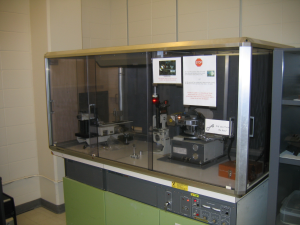Rigaku D/Max-B diffractometer

X-Rays are produced by a 1.8 kW, Cobalt target, sealed tube. These diverging x-rays are incident upon a flat, vertically mounted sample and the reflected or diffracted beam then converges (is “focused”) into a diffracted beam monochromator which removes all radiation except the Co Kα wavelength (~1.79 Å) which then enters a scintillation counter. The sample and detector are rotated with respect to the incident beam at angles theta and 2-theta, respectively. A typical XRD scan consists of a plot of detector angle (2-theta) vs diffracted intensity. These diffractograms can be printed out or saved to disk in application-friendly ASCII format. Analysis can be carried out in the facility using any user PCs equipped with qualitative and quantitative XRD software and access to the latest ICDD powder diffraction file database.
Most powder, thin-film, and bulk samples are acceptable. The sample holders can accommodate samples up to 30x30x10 cm in size (sometimes larger) with the 30x30cm surface tangent to the diffracting circle. The amount of material needed for a diffraction pattern depends on the diffracting power of the sample and the type of analysis desired. For example, phase identification of a well crystallized powder, with small (< 40 mm) particle size, may only require 1 mg or less. If you are uncertain about the type or amount of sample to bring or prepare for x-ray diffraction, please contact the facility specialist.
For more detailed information and specifications on this instrument, please see the files page.